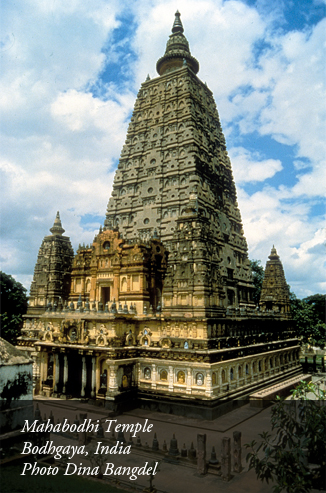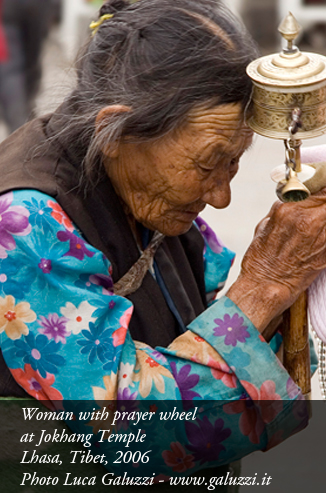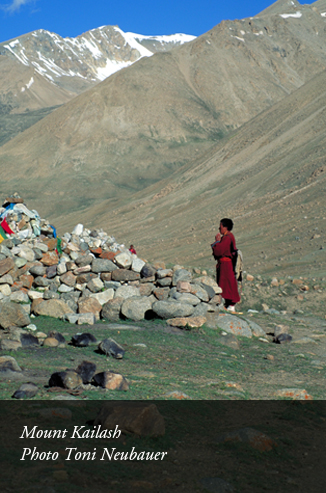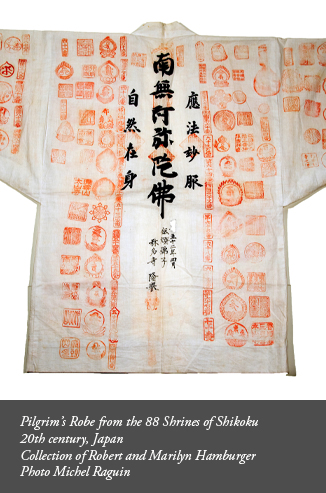





Buddhist Pilgrimages
"And they, Ananda, who shall die while they, with believing heart, are journeying on such pilgrimage, shall be reborn after death, when the body shall dissolve, in the happy realms of heaven."
As the world's fourth largest religion with more than 350 million followers, Buddhism's foundational creeds are non-violence (ahimsa) and the development of the qualities of loving kindness (maitri), altruistic compassion (karuna), and wisdom (prajna). These basic tenets of Buddhism were taught by its founder Shakyamuni Buddha, who himself was an ordinary mortal, born as a prince in 5th century BCE India who attained enlightenment (bodhi) through rigorous meditation and self-transformation. For Buddhist practitioners, Shakyamuni's life serves as a paradigm of this spiritual path, that full awakening is accessible to every living being, and enlightenment may be attained anywhere, anytime, through any method, as long as it is vigorously pursued. Hence, pilgrimage to the sacred places associated with the historical Buddha Shakyamuni becomes one of the most visible and enduring expressions of religious practice throughout the Buddhist world.
Called tirtha yatra in Sanskrit, "a journey to the ford/crossing," Buddhist pilgrimage serves as a means to accrue merit and as an act of purifying the physical body through the sacred journey. The goal of Buddhist pilgrimage then is to profoundly change the practitioner through the transformative experience, both mental and physical. Art supports the ritual of pilgrimage as the engagement of a journey, the acts of merit-making, charity and alms-giving during the process and beyond, sacred viewing at the site, and construction of memory through ephemera.
(continued)
From the earliest literary reference as indicate by the quote above, India was the sacred land for Hinduism, Buddhism, and Jainism. From as early as the lifetime of Shakyamuni Buddha (c. 563- 483 BCE), pilgrimage to India, the birthplace of the religion, naturally became the center of the Buddhist pilgrimage tradition. Sites related to the major events of the Buddha's life, known as the Eight Great Sites of Wonder (Astamahapratiharya), lie at the core of all Buddhist pilgrimage. These include the place of his birth at Lumbini, his enlightenment at Bodhgaya, India, his first Sermon at Sarnath, and his death at Kushinagara and the sites associated with his four great miraculous events. The earliest art of Buddhism, from as early as the 1st century BCE, represents the visual narratives of pilgrimage.
Pilgrimage in the Buddhist tradition highlights the centrality of relics and their power. Because being in the presence of a relic and taking darsan ("sacred viewing") of relics accrues merit, visiting the sites where relics are found is a principal impetus for pilgrimage in Buddhism. Sites associated with the physical relics (e.g., a tooth, a hair, or ashes from cremation) of the historical Buddha and relics by association (e.g., places made sacred by his presence, or a bowl or robe used by the Buddha) therefore map the sacred Buddhist landscape of India. A third category of relics is consecrated paintings or sculptures, which serve as reminders of the sacred sites. The objects associated with this relic category include not only art works of high artistic skill and materials such as gold, silver, silk or bronze, but also ephemeral objects of paper and clay that embody the experience and power of pilgrimage for the practitioner.
Buddhist practice has supported the re-creation of surrogate pilgrimage sites. In regions far from the Buddhist sacred center of India where there was little possibility of visiting the core sacred sites of Buddhism, Indian sacred sites were frequently re-created.
(continued)
This symbolic reconstruction created surrogate pilgrimage sites and produced a localized sacred geography and landscape. Many among these are associated with the natural world as the tangible expressions of the sacred in the natural world. These surrogate sites were often found in beautiful natural settings in distant places, where the rigors of travel became central to the pilgrimage experience. The remote Mt. Kailash in northwest Tibet, considered the center of the Buddhist, Hindu, Jain, and Bon world systems, is one such sacred place. Ritual circumambulation around the base of the 22,000 foot mountain is a merit-making activity that takes four days. Indeed, in Tibet a Buddhist pilgrim is often described as a person who goes around a sacred place. These journeys reinforce the conception of the physical landscape as sacred.
Pilgrimage sites are fluid; they transform to meet needs of devotees. First, they live in memory for those who have experienced the physical journey to the site itself. But, in many cases the original pilgrimage sites are replicated for easier access. The Bodhisattva of Compassion, Avalokiteshvara, has widespread devotion across Asia. Known in Japan as Kannon, the Bodhisattva is chiefly honored through a pilgrimage in Saikoku (Western Provinces) in central Japan that was eventually replicated at some 230 different places in the country. In the twenty-fifth chapter of the popular sacred text, the Lotus Sutra, Kannon appears in thirty-three different forms to save all sentient creatures. This Mahayana Buddhist text presents the powerful concept that multiple emanations of individual deities manifest a unified spiritual whole. Mahayana thinkers believe in the permanent presence of the Dharma or Buddhist Law in all spheres of existence, and assert that countless Buddhas and Bodhisattvas fill the universe to assist sentient beings in their spiritual quests.
(continued)
Just as the historical Buddha Shakyamuni presented multiple versions of himself walking, standing, sitting, and lying down during the miracles at Shravasti in India, so too other deities, like Kannon, present multiple versions of themselves. The Pilgrimage to the Thirty-Three Holy Places of Kannon in the Western Provinces is a 1500-mile route including clusters of temples in the city of Kyoto, as well as temples in the remote countryside, by the sea or lakes or in the mountains. Pilgrims begin the Saikoku Pilgrimage at Seigantoji at Nachi on the coast due south of Kyoto. Just as pilgrims venerating the Eighty-Eight shrines on the island of Shikoku, they often wear a white coat or a simple white shirt on which the names of the temples visited can be stamped.